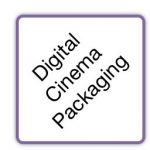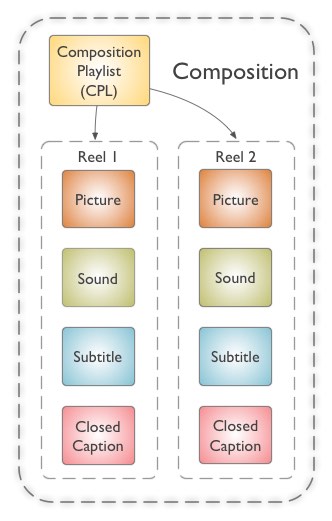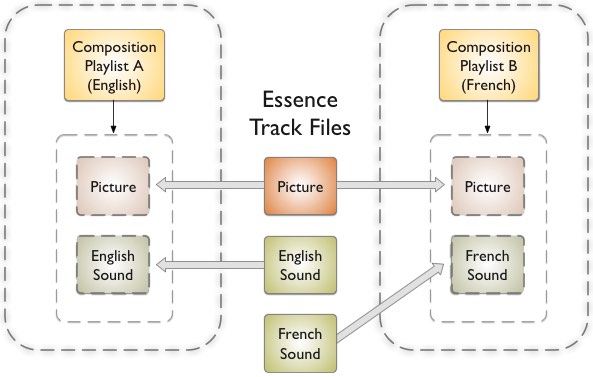
A Composition is a complete version of a work product, or title. The Composition consists of multiple files comprising a playlist and at least two Track Files. For flexibility and extensibility, each Track File carries only one type of essence, such as picture, sound, or subtitles. The manner in which the files are to be played is specified in a playlist, called the Composition Playlist, or CPL.
By definition, a Composition must have at least three files: a Composition Playlist (CPL), a Picture Track File, and a Sound Track File. In addition, Track Files can be divided into multiple files consisting of temporal chunks of essence called Reels. The name “reel” comes from film distribution, where a movie is shipped as temporal chunks of film, or reels of film. Reels makes it easier to physically ship the movie. But it is also easier to deliver a last minute edit when changing only one reel of a movie, which might happen due to a correction in credits, or a product placement change. Similarly, certain efficiencies are possible in digital distribution and production when organizing digital content in temporal chunks, leading to the organization of Compositions in digital Reels.
The illustration below depicts a Composition consisting of a Composition Playlist and four types of essence Track Files (Picture, Sound, Subtitle, and Closed Caption), temporally organized as two Reels.

Figure CPL-1. Composition Structure
In practice, a Composition might contain as many as 100 files, or more. The only limit to the number of track files is that imposed by the rules for encryption.
Multiple versions of a title often exist. Different versions might be necessary to accomodate 3D, subtitles, censorship cuts, or additional language sound tracks. For each version, a different Composition must be created. While this may sound inefficient, the single-essence-per-file rule encourages efficiency by allowing file assets to be shared among versions. As an example, different Compositions, representing versions of a title, intended for distribution in different countries may have different Sound Track Files, but carry the same Picture Track File. This example is illustrated below.

Figure CPL-2. Composition Versions with Shared Picture Essence Asset
Similarly, a 3D Picture Track File could be exchanged for the Picture Track File shown above, along with new CPLs, to define 3D versions of the movie. In this manner, many versions of the movie can be distributed without the need to send duplicate Track Files.
The Composition architecture, when first proposed in late 2001, was a distinct departure from any prior media format used in distribution. Prior distribution media formats characteristically married essence types into a physical form, such as a book, a DVD, a film print, or into a married electronic form, such as a television broadcast signal. Notably, it is a characteristic of the motion picture business to distribute motion pictures in somewhat customized versions, such as a version with a particular sound format, captions, a particular aspect ratio, or in one or more languages. This is driven by community requirements and equipment limitations, which often require cinemas to present more than one version of a movie over the course of an engagement. The Composition architecture was conceived to efficiently address the need to distribute multiple versions of a movie to a cinema by providing a mechanism for sharing essence files among versions.
The concepts behind the DCP and Composition, as described in this and the prior section, are explained in further detail in SMPTE ST 429-2 DCP Operational Constraints, the top-level standard for SMPTE DCP. These concepts were first put to work in the pre-standard Interop DCP, as explained here. Interop DCP remains in use today, although it is recommended that distributions transition to the newer and better documented SMPTE DCP.
(For those interested in the history of the Composition, the first public presentation on the concept was given by Michael Karagosian at NAB 2002, and available here.)